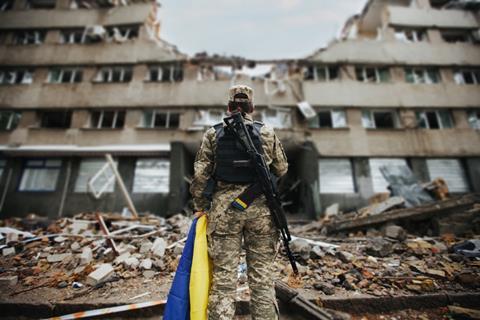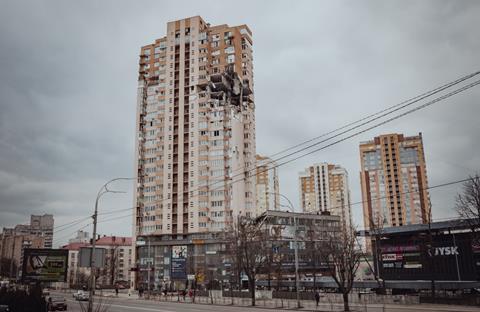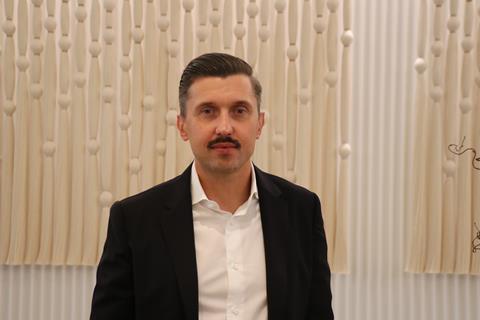Ukraine’s government cannot wait for the war to end before planning its rebuild. But there is a lot of work to do before the country can attract the foreign businesses it will need to build back better. Daniel Gayne reports.
Colin Ross was busy with a call when the air raid sirens began wailing. Calmly, he reassured the person on the other end of the line that this kind of thing happens all the time – nothing to worry about, let’s finish the conversation. A minute later, a colleague rushed into the room.
It’s ballistic: time to get to the shelter. Barely another minute had passed when Ross and his colleagues heard the great whoosh and boom of air defences launching projectiles to intercept the incoming rocket.
Working in Ukraine’s capital in 2023 is not for the faint of heart. Ross, who is general director of Gleeds’ business in the country, tells this anecdote to illustrate the sense of precarity and uncertainty that looms over the land.
On a typical summer day, he tells me, Kyiv can seem a city like any other – people enjoying the long, warm evenings in cafes, restaurants and bars. But, in a moment, that sense of normality can vanish. “What happens is that you have normal life and then all of a sudden it changes very quickly,” he says.
This, most would agree, is a difficult environment in which to operate a business – particularly when that business involves putting up new buildings. It is a situation that poses a problem for Ukraine.
As the war, which began in February 2022, has dragged on into a slower, more attritional phase, it has become increasingly clear that the grand task of rebuilding the country will need to begin before a lasting peace is achieved. And clear, too, that foreign assistance – from both governments and private businesses – will be necessary to achieve this.

War tends to focus priorities and, in the first months after the Russian invasion, the objective was simple: defence at all costs. Ukraine’s construction industry was by no means exempt from being drafted into the service of this goal.
Sergii Pylypenko, chief executive of the Kovalska Group, Ukraine’s biggest building materials manufacturer, remembers it well. “For almost six months, there was no activity on the market […] the only way we remained active was by providing our products to our army to build defences,” he tells me.
“At the beginning we gave products for free – when Kyiv was almost encircled in March 2022, we gave everything we had in our stock that could potentially stop the Russian army.”
Once the initial invasion was rebuffed, the work of construction defences and rebuilding essential infrastructure became more formalised and Kovalska began to take big orders to build fortifications around Kyiv and Chernigov in northern Ukraine, as well as civil defence structures such as air raid shelters. While a private market for building began to return from the late spring of 2022, it was at a tenth of its previous level for Kovalska, which survived on its work for the government.
“When Ukraine’s recovery proposal was generated and published, the thought was that state aid would fund the majority of it […] it has become apparent that is not possible.”
Colin Ross, general director, Gleeds Ukraine
For the majority of the war, the focus of rebuilding work – led by the Agency for Restoration and Infrastructure Development (ARID), which has 24 offices across the country – has been largely reactive, consisting of emergency fixes to major infrastructure like pipelines and the supply of water and electricity. Since the end of the difficult first winter, work has moved from emergency fixes to essential infrastructure to the rebuilding of roads and bridges to re-establish links between towns and cities. Meanwhile the government has begun to turn its attention to the broader task of rebuilding a war-ravage society.
According to the latest estimates by the Kyiv School of Economics, the war with Russia has caused $147.5bn worth of damage to the country’s infrastructure so far. Early in the war President Volodymyr Zelensky set up a national recovery council responsible for developing a plan to “build back better”, which published an outline recovery plan in July 2022.
Last month, governments, financial institutions, international organisations, businesses and civil society groups came together in London for the second Ukraine Recovery Conference, which saw the EU announce a multi-year facility of up to $50bn to support recovery, reconstruction and modernisation of the country. In the same month, Bechtel announced it had signed a memorandum of understanding with ARID, while Aecom announced it had agreed a similar deal with the agency as well as one with the Ministry for Communities, Territories and Infrastructure.
Bechtel’s work will include restoring critical infrastructure, including the Kakhovka Dam, as well as masterplanning and providing technical services for logistics and transportation. Aecom will serve as Ukraine’s reconstruction delivery partner.
“Preliminary, early-stage planning – even while the war continues – is essential so that the right foundation is in place for reconstruction and restoration to advance at the necessary pace and scale as soon as possible,” Colin Wood, Aecom’s chief executive for Europe and India, told Building.

Pylypenko, too, has been busy preparing for the next stage of reconstruction. The executive was in the UK recently making the case for private foreign investment in Ukraine.
His company recently announced that it had attracted a 10-year, €27m loan from the Dutch government’s export agency to build a new autoclaved aerated concrete plant in the west of Ukraine. But even he acknowledges that the domestic built environment sector is not big enough to meet the scale of the rebuild.
Labour alone is a challenge, with many workers having joined the army or fled the country. Kovalska, which had been a £400m turnover company before the war, is currently running at 50% of its pre-war staffing and more than 20 of its employees have so far died in the conflict.
“There will be a need for assistance,” says Gleeds’ Ross. “When Ukraine’s recovery proposal was generated and published, the thought was that state aid would fund the majority of it and, in the year and a half that we have had the war, it has become apparent that is not possible.”
As far as British and American built environment firms are concerned, “everybody is looking”, says Ross, who names Aecom, Arup, Bechtel, Jacobs and Mott MacDonald as firms likely to be in the mix. The challenge at the moment, Ross tells me, is that no single organisation has taken charge of leading the rebuild.
“You don’t know who to chase, you don’t know who to try and connect with,” he explains. “As we get to the stage of real major rebuilding works, there will have to be plans in place and then it will be much easier for people to understand what is going on. At the moment, we have not really got there yet”.
Building back better

Reconstruction will not simply be a matter of replacing what has been destroyed in Ukraine. The government has stressed its intention to “build back better” and, in the most damaged parts of the country, will be faced with the rare opportunity to overhaul city plans developed to support the Soviet Union’s state socialist economic and political model.
“For sure, the task is not just to build how it was,” says Pylypenko. “The goal is to build sustainable areas of cities that will be energy efficient, that will use sustainable materials, that will be more focused on the quality of living of the people.
“A lot of cities were built during the Soviet Union era. The life cycle of these builidngs was not more than 50 years but people still live in them. Even if they were untouched by the war, these buildings need to be rebuilt completely, and you cannot just go building by building, it needs to see the whole territory.”
In Kharkiv – a city in the north-east which remains under intermittent Russian fire – the Norman Foster Foundation is working with the UN and the local mayor to produce a masterplan and vision for how the city could be transformed post-war. Ross says foreign businesses have the opportunity to “come in and enhance what is already here”, opening up possibilities for reconstruction that would not otherwise be available.
He gives the example of modern methods of construction, which is not prevalent in the country, as a technology that could help to rebuild at the scale and speed now required in Ukraine.
Ross once again stresses the need to plan from the very beginning – and with an appropriate level of national oversight. “You could end up in a situation where you have got three villages in very close proximity each with a damaged school. At the moment, because of the way the structure is, it is very difficult to stop those villages each rebuilding their school,” he explains.
“What would be better would be to build one school for all three or five villages. You would have a much better education system and a much better building. Those sorts of opportunities need to be grasped now, otherwise we are just rebuilding what we had – and that is not building back better, necessarily.”
It remains unclear how international support will be structured. In the original recovery plan drafted by Ukraine’s government, donor countries were to be encouraged to assist in particular areas – the UK, for instance, would have assisted in the redevelopment of Kyiv. But Ross says the tide is beginning to change towards a sectoral approach, where allies are tasked with the construction of a particular industry, such as education.
The impact of this decision alone could have a massive impact on the opportunities that will be available to foreign built environment firms. It also remains to be seen which entity will be taking the lead on contracting.
Ukraine has traditionally had a very powerful central government (ARID’s remit is so wide that it is known locally as “the ministry for everything”), but its rebuild plans are complexly intertwined with ambitions for EU succession and the country is being strongly encouraged to decentralise – something which Ross says could be a major challenge for regions with little experience of this kind of power.
In Ross’ view, someone – possibly outside the domestic government – needs to take charge of the process. He gives the example of the Marshall Plan, the United States’ economic recovery plan for western European economies at the end of the secound world war.
“One of the benefits of that was it was economists that created it and they looked at it completely dispassionately and asked, ‘where do we need to start from’? You can’t rebuild everything at once, so you need to prioritise.”
Ross thinks this phased approach – which would among other things give foreign governments and companies greater insight on what work is likely to be available when – would only work if it was run by an independent, apolitical body. “Ukraine would be heavily involved in it, but it’s not the political decision-makers who would make that final decision, because otherwise it just won’t happen,” he offers.
“I am absolutely sure that we will win this war and gain back the whole territory”
Sergii Pylypenko, chief executive of the Kovalska Group
Whether any such body is likely to come into being is unclear. What is more obvious is that, without a clear plan, foreign companies are likely to stay away from such an inherently challenging market. Even Kovalska faces difficulties in planning its investment.
The firm has been very involved in bridge building and has a full order book until January next year for its precast concrete beams – but it is difficult to know whether to invest in new capacity. If you do not know how long the war will last, then you do not know how long Russian warplanes will continue to obliterate your vital infrastructure. And, when you do not know that, it is difficult to know whether to buy a new factory.
Another challenge in attracting foreign businesses is perceptions about the legal system. Ross says he is aware of at least one big UK-based consultant that has experienced judicial problems.
“There have been concerns previously about the rule of law – they are trying to address that but that does prevent some people coming into the market,” he says.
More on Ukraine
>> Meet the Korols: How one Ukrainian family found refuge in the UK construction sector
>> This is our land: One year after invasion of Ukraine, Gleeds employee explains why she stayed
>> Rebuilding Ukraine will be neither quick nor easy. We should start planning now
Aecom’s Colin Wood says the Ukrainian government could provide more comfort to foreign companies by adopting government-to-government agreements which provide a legal and regulatory framework that offers more stability and transparency to outside firms. “International construction and engineering firms have a vital role to play in a successful Ukraine recovery effort, but their successful participation will require national governments to create the space for them to operate safely, securely and efficiently,” he says.
“We’ve seen frameworks like this work before in other conflict or disaster scenarios, and implementing these agreements as soon as possible would ensure international companies are afforded the necessary legal protections so they can more fully commit their resources to supporting the reconstruction of Ukraine during and post-conflict.”

The other big concern, of course, is security. Since 2014, foreign investors have been avoiding eastern territories in the Donbas and today the areas considered safe are much further west.
Ross, who had spent around 16 years in Ukraine since first moving there in 1997, took his family to live in Manchester when the war began. They are still based in the northern English city but he now spends around 10 days each month in Ukraine.
It is only very recently, Ross says, that USAID and World Bank staff have returned to Kyiv in substantial numbers and even Aecom does not yet have boots on the ground.
“The private sector is not going to work in an area that is insecure,” says Ross, whose office is half a kilometre away from the site of a successful missile strike. “Even if there is insurance in place, they are not going to go and work 10km from the front line.”
Until there is some kind of well-established peace, he adds, companies will “be selective in where they go”.
Whichever way you square it, Russia itself will be a major factor in when and where serious rebuilding begins to take place. Until then, Pylypenko suggests that British companies in the built environment sector research the market and forge links with their Ukrainian peers to put themselves in a good position to support the rebuild when it begins.
“I am absolutely sure that we will win this war and gain back the whole territory – even those bits that have been occupied since 2014,” he says. “Ukraine will be the biggest market in continental Europe for construction services and building materials, and the sooner European companies look closely at this market and establish small teams or partnerships with local players to understand the structure of the market and to find out the opportunities the better.
“This window of opportunity is quite short and, in the next couple of years, it will become clear who the leaders will be.”
Additional reporting by Amber Buthfer



























No comments yet